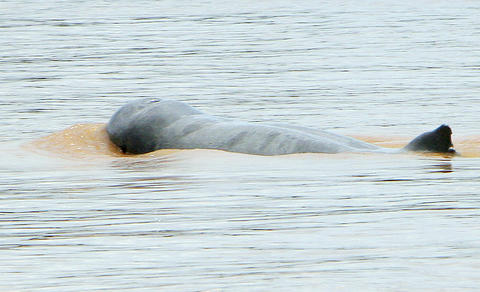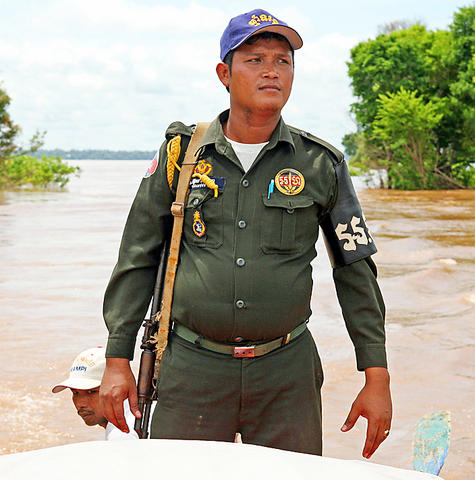The absence of fishing boats on this stretch of the Mekong River, just a few kilometers north of the eastern Cambodian town of Kratie, means military policeman Em Pheap is doing his job.
One of about 80 "river guards," he is part of a groundbreaking conservation effort which has been credited with helping pull the Irrawaddy dolphin back from extinction.
"There, there!" he pointed excitedly during a recent patrol on the river, shouldering his assault rifle and standing high on the back of the boat.

PHOTO: AFP
The pair of dolphins, dark slivers on the horizon, broke the surface with a gentle exhale of breath heard over the murmur of the current running through the submerged trees in this vast monsoon season flood plain.
The total number of Mekong dolphins is unknown, but marine specialists say the mammals remain some of the world's most critically endangered.
With their pale gray skin and blunt beaks, the dolphins resemble porpoises more than their sea-going cousins.

PHOTO: AFP
Their numbers already vastly reduced by Cambodia's drawn-out civil conflict - dolphin blubber was used to lubricate machine parts and light lamps - these graceful creatures are now falling prey to development and the attendant problem of over-crowding as this wild corner of the country opens up.
The Mekong is one of only five freshwater habitats in the world for this species of dolphin, and Cambodia supports its largest remaining population, thought to hover around 100 congregating in natural deep-water pools.
"The Kratie-Stung Treng stretch of the Mekong is their last stronghold," said Richard Zanre, the World Wildlife Fund's (WWF) freshwater program manager in Cambodia, describing a river habitat running 200km from Kratie to Stung Treng, Cambodia's last large port before the Mekong crosses over into Laos.
War and the ensuing lawlessness kept the region largely out of the reach of researchers for decades. But since 2001, biologists and other wildlife experts have discovered an unexpectedly rich biosphere.
At its core are the dolphins, "a flagship species for the conservation of the river," says the WWF.
Desperate to revive a plummeting population, the government created the river guards, the first organization of its kind and part of a conservation effort launched last year after a spate of mysterious dolphin deaths.
But while the guards appear to have had some success in bringing dolphin numbers back up, they have been met with hostility and sometimes violence from local villagers who make their living along the river.
"The most important thing is to cooperate with the people," said Touch Seang Tana, chairman of the government's Commission for Mekong River Dolphin Conservation.
"Without the participation of the local people in conservation, we will not be successful."
A spike in deaths among dolphin calves last year left officials scrambling to re-think their conservation efforts as Cambodia prepared to launch one of its most ambitious tourism efforts to date: The Mekong River Discovery Trail.
The trail, which hopes to bring tourism and development to one of Cambodia's most neglected regions, roughly follows the dolphins' habitat.
The animals' survival is crucial to the plan's success, officials say.
"No dolphins means no tourism. No tourism means no development," Tourism Minister Thong Khon said last week as the trail, a joint UN-Cambodian project, was announced.
The solution, according to Touch Seang Tana, was to try to radically change the economy of the river to make dolphins more valuable alive than dead.
Alternate means of livelihood would be introduced to villages along the river to take advantage of a booming tourism sector that has already benefited other parts of the country.
"My idea is ... to try to get poor fishermen to change over to tourism," Touch Seang Tana said. "I give them tour boats" to bring visitors to see the dolphins.
Reducing villagers' dependence on fishing is hoped to also see a drop in the use of gillnets.
Cheap and easy to use, gillnets are as efficient a killer of dolphins as they are of fish, said Touch Seang Tana, a marine scientist by training who blames this now-illegal fishing method for 99 percent of dolphin deaths.
But getting local fishermen to risk their livelihoods for an animal that is of little value commercially or as food has been hard, he explained.
"I tried to invite them to meetings to explain our actions, even tried to pay them money
... . But they didn't come, they sent their pregnant wives," he said.
"We decided then that we'll confiscate (fishing gear) and then they came. They came with knives, they wanted to kill the river guards," he added.
"They want to kill all of the dolphins because they are keeping people from making a living."
Since the introduction of the river guards, however, illegal net fishing, along with the use of explosives or electrical charges to catch fish - practices that also inadvertently kill dolphins - have dropped, said guard Em Pheap.
"Before it was a big problem, but now people are understanding more about this," he said.
The WWF's Zanre said that while the number of dying dolphin calves is still dangerously high, "adult dolphin mortalities have declined" as a result of conservation.
Even before the Discovery Trail becomes a reality, its successes are evident in Kampi, where dolphins have become the local industry.
Aside from the boats lining up for sightseers, nearly every house along the narrow tree-lined road shadowing the river hawks tiny dolphin carvings.
"Everyone earns the money, even the children, from dolphins. You can see their livelihood has changed - you can see televisions in houses, some people even have motorcycles," Touch Seang Tana said.
"The dolphin is so important. I tell them 'The dolphin is everything for you' and now they can see that," he added.
"Its future is their future."

Seven hundred job applications. One interview. Marco Mascaro arrived in Taiwan last year with a PhD in engineering physics and years of experience at a European research center. He thought his Gold Card would guarantee him a foothold in Taiwan’s job market. “It’s marketed as if Taiwan really needs you,” the 33-year-old Italian says. “The reality is that companies here don’t really need us.” The Employment Gold Card was designed to fix Taiwan’s labor shortage by offering foreign professionals a combined resident visa and open work permit valid for three years. But for many, like Mascaro, the welcome mat ends at the door. A

Last week gave us the droll little comedy of People’s Republic of China’s (PRC) consul general in Osaka posting a threat on X in response to Japanese Prime Minister Sanae Takaichi saying to the Diet that a Chinese attack on Taiwan may be an “existential threat” to Japan. That would allow Japanese Self Defence Forces to respond militarily. The PRC representative then said that if a “filthy neck sticks itself in uninvited, we will cut it off without a moment’s hesitation. Are you prepared for that?” This was widely, and probably deliberately, construed as a threat to behead Takaichi, though it

Nov. 17 to Nov. 23 When Kanori Ino surveyed Taipei’s Indigenous settlements in 1896, he found a culture that was fading. Although there was still a “clear line of distinction” between the Ketagalan people and the neighboring Han settlers that had been arriving over the previous 200 years, the former had largely adopted the customs and language of the latter. “Fortunately, some elders still remember their past customs and language. But if we do not hurry and record them now, future researchers will have nothing left but to weep amid the ruins of Indigenous settlements,” he wrote in the Journal of

If China attacks, will Taiwanese be willing to fight? Analysts of certain types obsess over questions like this, especially military analysts and those with an ax to grind as to whether Taiwan is worth defending, or should be cut loose to appease Beijing. Fellow columnist Michael Turton in “Notes from Central Taiwan: Willing to fight for the homeland” (Nov. 6, page 12) provides a superb analysis of this topic, how it is used and manipulated to political ends and what the underlying data shows. The problem is that most analysis is centered around polling data, which as Turton observes, “many of these